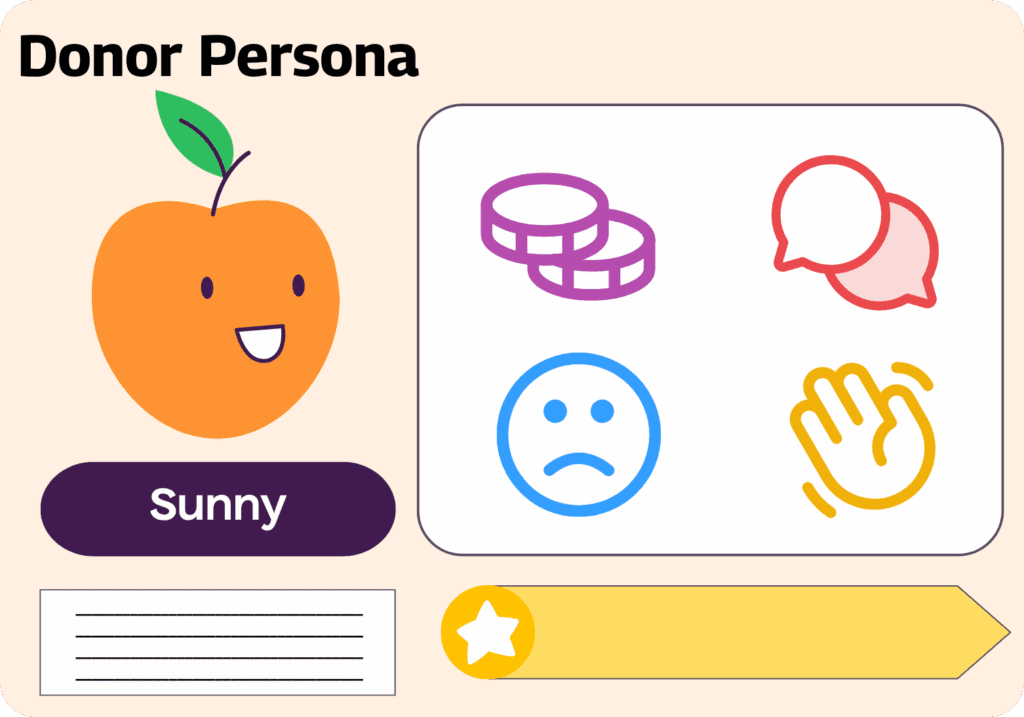When a donor gives to your organization—especially if it’s their first one—you enter the stewardship phase. This is where you communicate with the donor, express your gratitude, and work on nurturing your relationship so the donor continues to give and be an active member of your community for years to come.
And it all starts with a thank you letter.
Curious about how to write a sincere and meaningful thank you letter? Read on to learn our top 15 tips for writing the perfect thank you letter, browse inspiring samples, and get your hands on ready-to-use templates you can customize and start sending to your donors.
Let’s take a look!
Why Thank You Letters for Donations are Important
A great thank you letter is much more than just a receipt or confirmation that a transaction has taken place. Here are a few reasons why thank you letters are so important:
- They allow you to express gratitude
There are thousands of other nonprofits and amazing causes out there, yet the donor chose to support yours. Use the thank you letter to express just how grateful you are for their contribution and reassure them that they made the right decision.
- They make the donor feel valued
Your organization wouldn’t be able to do the work that you do without the support of donors. Make sure they know just how much you need and appreciate them by sending a sincere thank you letter.
- They help nurture your relationship with the donor
Every interaction and communication you send to the donor helps build your relationship with them. The first thank you letter you send is often the start of that relationship and will inspire the donor to keep giving and keep engaging with your organization.
- They’re a part of good donor stewardship
Good donor stewardship means making sure the donor has a positive, meaningful experience with your organization. It has a direct impact on your donor retention rate and future fundraising since donors who have an outstanding donor experience are much more likely to give again and often increase the rate and amount of their giving.
Types of Thank You Letters for Donations
There are many different types of donations, and there are different thank-you letters associated with each one. Here are some of the most common kinds of letters and when to send them:
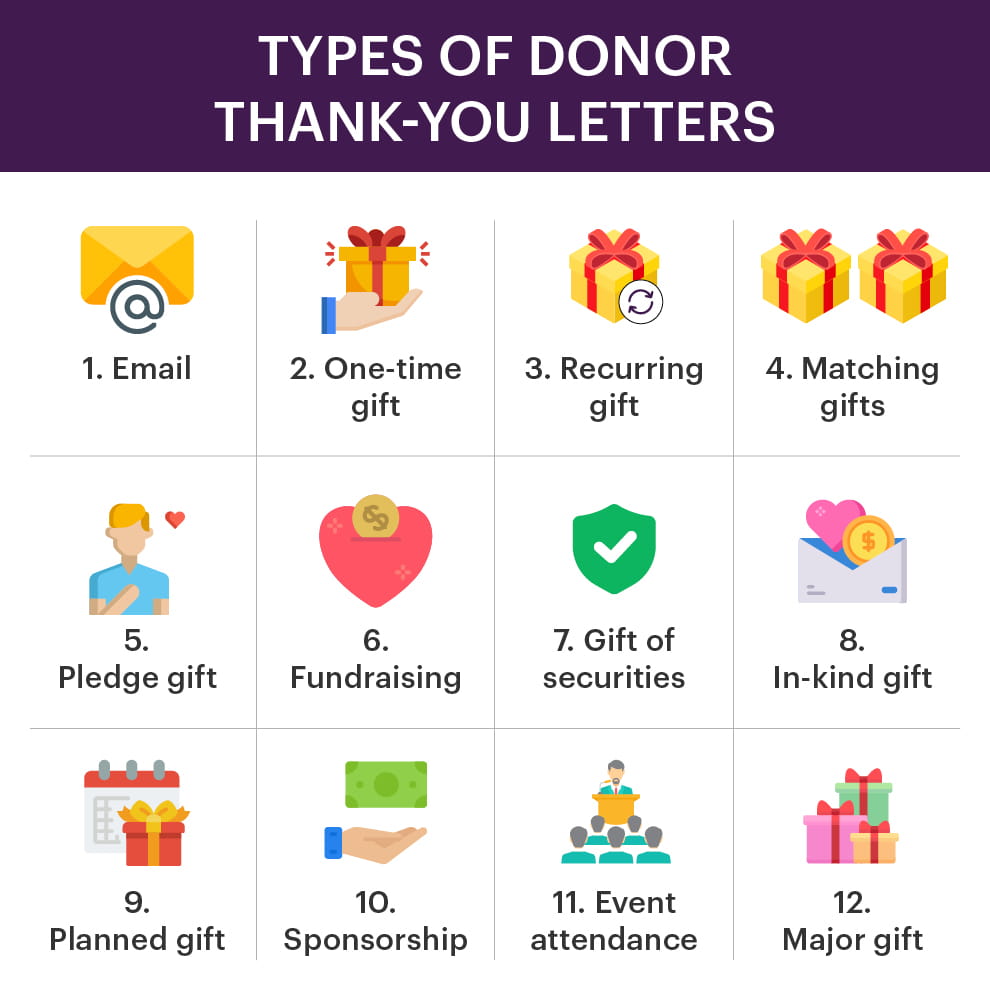
1. Email: Send a quick thank you note for online donations that don’t require a tax receipt or donations to peer-to-peer fundraising campaigns (though be sure to send a physical letter to the people who raised funds from their friends and families). An email thank you lets you show your acknowledgment and appreciation for donors right away.
2. One-time gift: Send a physical thank you letter for any one-time gifts over a certain amount and include a tax receipt.
3. Recurring gift: For donors who give monthly, there’s no need to send a new thank you letter every month, but do send a nice message once a year to recap their giving and its impact.
4. Matching gifts: When a supporter goes out of their way to help your nonprofit earn extra revenue through a matching gift, send them a thank you letter. If possible, send the thank you letter right after they submit their matching gift request to their employer instead of waiting to receive the payout from the employer, which can be a protracted process.
5. Pledge gift: Send a thank you letter to individuals or organizations who make a pledge — a promise to donate a certain amount over a certain number of years. Don’t forget to send a separate thank you note after each of the installments comes in.
6. Fundraising: For donors who participate in fundraising events or campaigns, send a thank you letter to show appreciation for their support and effort in rallying the community. You can include a recap of the fundraising campaign and a personalized note about their impact to show that they are part of something bigger.
7. Gift of securities: Send a thank you letter to anyone who makes a gift in the form of stocks, bonds, or mutual funds.
8. In-kind gift: Send a thank you letter to individuals or organizations who make in-kind donations (for example, items to sell at your auction).
9. Planned gift: Send a thank you letter to donors who leave your organization in their will. In this case, all of your stewardship efforts should happen before you actually receive the funds.
10. Sponsorship: Send a special thank you to companies who sponsor your events and programs.
11. Event attendance: Send a thank you letter to every event attendee, especially if part of the ticket cost is considered a donation.
12. Major gift: For major donors who give a substantial amount and already have an established relationship with your organization, most templated letters will come across as insincere. Instead, consider asking your leadership to write a handwritten thank you note.
15 Best Practices For Your Nonprofit Thank You Letter
1. Use the donor’s name
Nothing says, “This is a form letter” more clearly than failing to include a donor’s name. Starting your thank you letter for a donation off with “Dear Friend” makes people feel like your nonprofit doesn’t care — not the tone you want to set in a thank you to donors!
Mail merges make it easy to add names and personal details to your thank you letters. It’s a small thing, but it makes a big difference in how your donors will feel.
2. Send it promptly
The faster you can get your thank you to donors, the better. A prompt thank you allows you to extend the good feelings the donor has about making a gift and heads off any buyer’s remorse that may otherwise set in.
Send your thank you message within 24-72 hours of receiving a gift. This ensures that:
- Donors feel appreciated immediately
- Donors remember they gave to your organization
- Donors don’t accidentally get solicited again before they’re thanked.
3. Send it from a person
Letters feel the most personal when they’re from one person, not an entire organization. Often, you’ll want to go with the “top-ranking” person at your organization, like your executive director or chair of your board, but consider making the sender a volunteer or client impacted by your programs.
4. Show impact
Your thank you for a donation is part of your donor communication stream, and a chance to tell them more about your mission, and their impact. Donors want to know that the money they’ve given is making a difference, so reference how you’ll use it.

This letter from water.org shows the impact of a gift by quickly telling the story of Anisa, and how access to clean water changed her life.
5. Be warm and friendly
Receiving a thank you for your donation should feel good. Keep the tone warm and friendly, not stiff and formal. As you write your letter, picture a volunteer or donor that you like and appreciate, and imagine you’re writing only to them. Avoid overly lofty language like, “on behalf of X Organization.” Instead, talk to your donors like friends.
6. Use donor-centered language
A thank you letter is about acknowledging your donors, not singing your own praises. Keep the focus on the donor and their contributions by using “you” more than “we/us” and talking about what the donor has made possible, rather than what your organization does. Key phrases include:
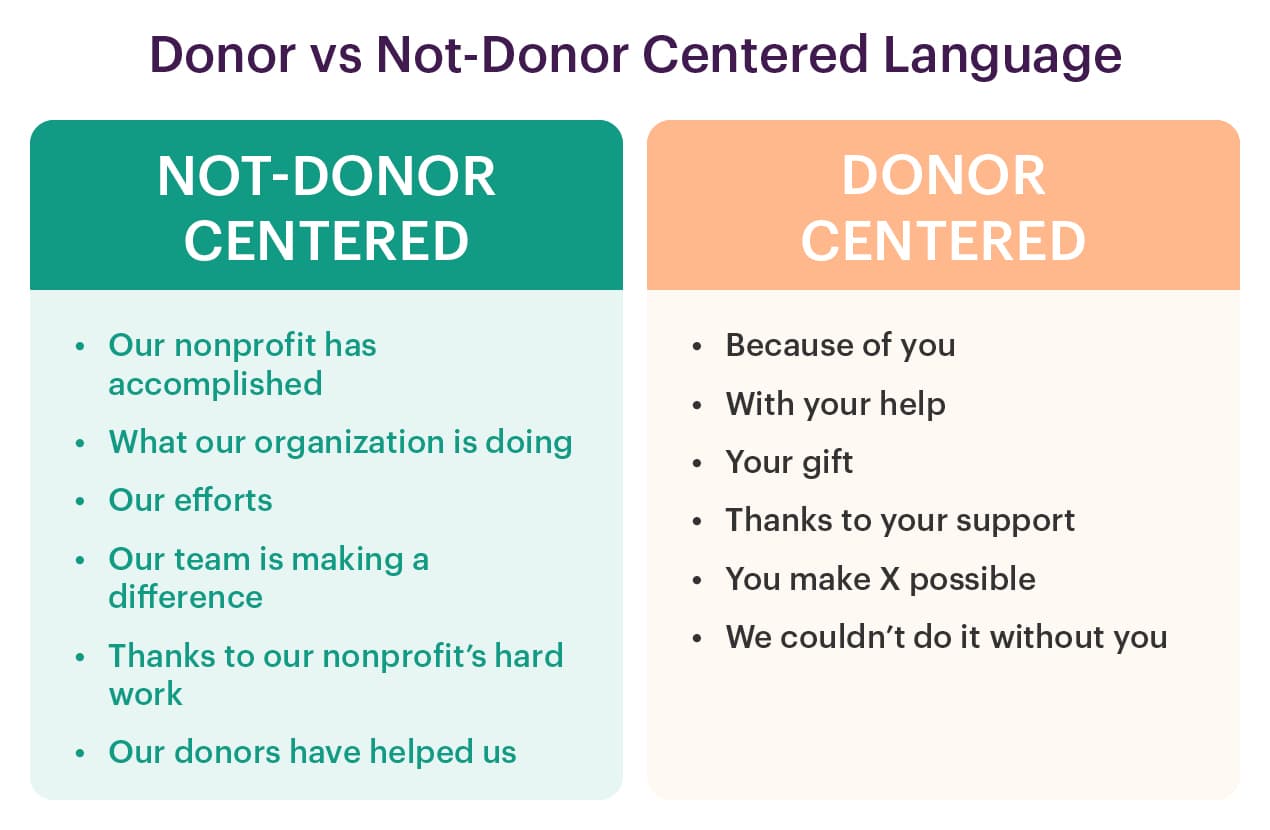
- “Because of you”
- “With your help”
- “Your gift”
- “Thanks to your support”
- “You make X possible.”
- “We couldn’t do it without you.”
7. Avoid empty jargon
Nonprofits have a lot of sector-specific jargon that means a lot if you work in the field and means absolutely nothing if you don’t. Keep that jargon out of your external communications, including thank you letters to donors.
Your average donor won’t connect with phrases like “launching a capital campaign,” or “capacity-building grant,” but they’ll understand “raising money to build a new library,” or “providing more meals to homeless people.” Say what you mean so they can get excited about it.
8. Reference their history
Loyal, recurring donors are a wonderful thing. Celebrate their loyalty and commitment in your thank you letters. Show them you know, remember, and value their contributions.
Make sure returning donors get a different thank you letter than first-time donors and use data segmentation and mail merges to personalize them with unique references to the donor’s history with your organization. For example:
- “Since 2010, you’ve supported people in our community who are battling addiction.”
- “I’m so glad you could attend our recent seminar on everyday actions for conservation.”
- “Thank you for being someone we can count on every year.”
9. Add personal touches
Make your thank you even more personal by adding hand-signed signatures and notes from relevant people. Check your contact database for relationships with staff and board members, recent event attendance, and other information that you can reference in your letter, or add in a hand-written note in the margins of the letter.
10. Offer more contact
Imagine a donor is so moved by your thank you that they want to learn even more about your organization. Make it easy for them to do so by including contact information for the letter sender, along with links to your website, social media, and email (if the communication is electronic).
11. Don’t make a direct ask
A thank you letter is about appreciation for the donor, not your needs. Imagine you’re making your child write Grandma a thank you note for their recent birthday presents. You’d encourage them to express their thanks, and perhaps share a little about how they plan to use the gift. You wouldn’t let them make it all about what they want for Christmas, right? The same follows for nonprofit thank you letters–they are not a good opportunity for another ask.
Focus on gratitude — you can send another ask soon, but not before you’ve adequately expressed your thanks.
12. Include quotes and stories
The best people to speak about your nonprofit’s impact are the people you serve. Including quotes and stories from them can give your thank you letter more authenticity and drive emotion.
13. Add appropriate visuals
Use photos, videos, and infographics to show your donors the people they’ve helped, the places you’ve worked, and the changes you’ve made together. Information paired with images is remarkably more memorable, and can keep the good feelings from your thank you going even longer.
14. Keep it concise
If your thank you letter is too long or looks like one big block of text, donors will be less likely to read it. Instead, focus on only the important aspects of your message and keep it short and sweet.
While it’s important to show impact, you don’t need to write three paragraphs about how the funds will be spent. Leave this information for the annual report or an update you’ll be sending at a later point.
15. Include a tax receipt
The IRS requires an official tax receipt for donations over $250, but it’s a good practice to issue receipts for smaller donations, as well, since many donors use them to keep track of their finances.
Your tax receipts should include the name of your organization, your tax ID number, the name of the donor, the date and amount of the donation, and any legal statements that are applicable in certain situations.
For more details about how to issue tax receipts, check out the article Donation Receipts: Everything You Need to Know.
How to Write Your Own Thank You Letter for Donations
To write your own thank you letter, grab one of our templates and customize them to reflect your donors and their impact. Remember to keep it short and sweet — it’s better to send a brief letter that your donors will actually read, instead of a highly detailed one that will be skimmed at best.
Here’s what to include in your letter:
Intro:
Start with a statement of gratitude to set the tone for the rest of the message. Use this opportunity to personalize the letter as much as possible. Include the donor’s name, donation amount, their past contributions, their history with your organization, or any of their recent interactions with you (for example, event attendance).
This will give the donor a sense that you wrote the letter just for them, instead of using a generic thank you message for everyone.
Body:
In this next section, talk about the impact that the donor’s gift will have on your organization’s work. If they’ve given to the same cause before, talk about what their past contributions have helped you achieve.
Remember to always use donor-centric language (“you” instead of “we”). As much as you can, try to incorporate stories and quotes from real-life people who’ve benefited or will benefit from the donation.
Conclusion:
Here, you can reiterate your gratitude and invite the donor to get in touch with you should they have any questions or concerns. Include your contact info and, if possible, get a live signature from the letter’s signatory.
Whatever you do, do not ask for another donation in a thank you letter. You can do this later in a dedicated appeal.
Sample Thank You Letters for Nonprofits
To help you get inspired, we wrote three sample thank you letters — two for monetary donations, and one for in-kind donations.
Sample Letter 1: Long Version
Dear Luis,
Thank you for your donation to XYZ Nonprofit! It really makes a difference for the children in our community.
Thanks to you, kids have a safe place to go after school. Instead of going home alone while their families are at work, our kids are learning to play soccer and make art, forming friendships with peers and relationships with adult mentors, and improving their grades at our Homework Help Center.
Those three hours after the end of the school day can make a crucial difference in kids’ lives. Consider our friend Kim, age 10. Before joining our program, she’d walk home with her younger sister, and then lock the door until their mom got home. If she needed homework help, she had to wait. Thanks to your support, we were able to open a program at Kim’s school, and now, she and her sister go to XYZ Aftercare instead of their empty apartment.
Kim says it best: “XYZ Aftercare makes every day fun! I took a coding class, and have my homework done before I go home.” Kim’s mom adds, “She learns so much! I never felt safe having the girls alone so long, but couldn’t afford any other options.” Thanks to you, Kim’s family doesn’t have to worry about how to pay for this care, and Kim and her sister are somewhere safe and enriching every day after school.
Thank you again for your ongoing support of our kids!
Sincerely,
Alice Agency Director
Sample Letter 2: Email Version
Dear Luis,
Thank you so much for your generous donation to XYZ Nonprofit! We truly appreciate your commitment to the kids in our community.

Caption: In a recent all-city field day, the 4th graders at Blaine prevailed at tug-of-war against the 4th graders at McPherson. Thanks for pulling for everyone!
With your help, we’ve provided after-school care to 300 kids this year. They’re building healthy relationships with peers and adults, improving their grades, and having a great time in our after-school programs at six sites around the city.
We couldn’t do it without you! Thank you.
Sincerely,
Alice Agency Director
Sample Letter 3: For In-Kind Donation
Dear Luis,
Kids will be happily snacking after school, thanks to your donation of six cases of graham crackers. Healthy eating is an important part of our after-school routine, and we truly appreciate your support. Thank you!
I thought I’d share a couple of quotes from the kids with you:
“Snack is my favorite part of XYZ Aftercare!”–Ramone, age 6
“I like snack time because I can talk to my friends and eat something yummy,”–Zara, age 8
“Snacks are important because I have a lot of homework and my brain needs FOOOOOOD,” Joey, age 9
As you can see, your contribution is very important to our most important people, the kids we serve. It’s important to me, too. Your ongoing commitment to our kids truly means the world, and we really couldn’t do it without you, Luis.
Thank you!
Sincerely,
Alice Agency Director
Sample Letter 4: Matching Gift Version
Dear Luis,
Thank you for your donation to XYZ Nonprofit! Your generous gifts go a long way toward helping our community’s children.
By going the extra mile to request a matching gift, your support goes even further to helping kids have a safe place to go after school. With both your and your employers’ contributions, we were able to purchase new sports equipment to ensure our kids are happy, active, and cared for.
Thank you again for your and your employers’ generous ongoing support of our kids!
Sincerely,
Alice Agency Director
Bonus: Check out extra tips and tricks for writing letters for every part of the matching gift process.
Nonprofit Thank You Letter Templates
When you’re ready to prepare your own thank you letters, start with one of our templates and customize them to fit your needs. The above samples were based on these very templates! Keep reading to see a preview of each template or click here to download them.
Template 1: Email Version
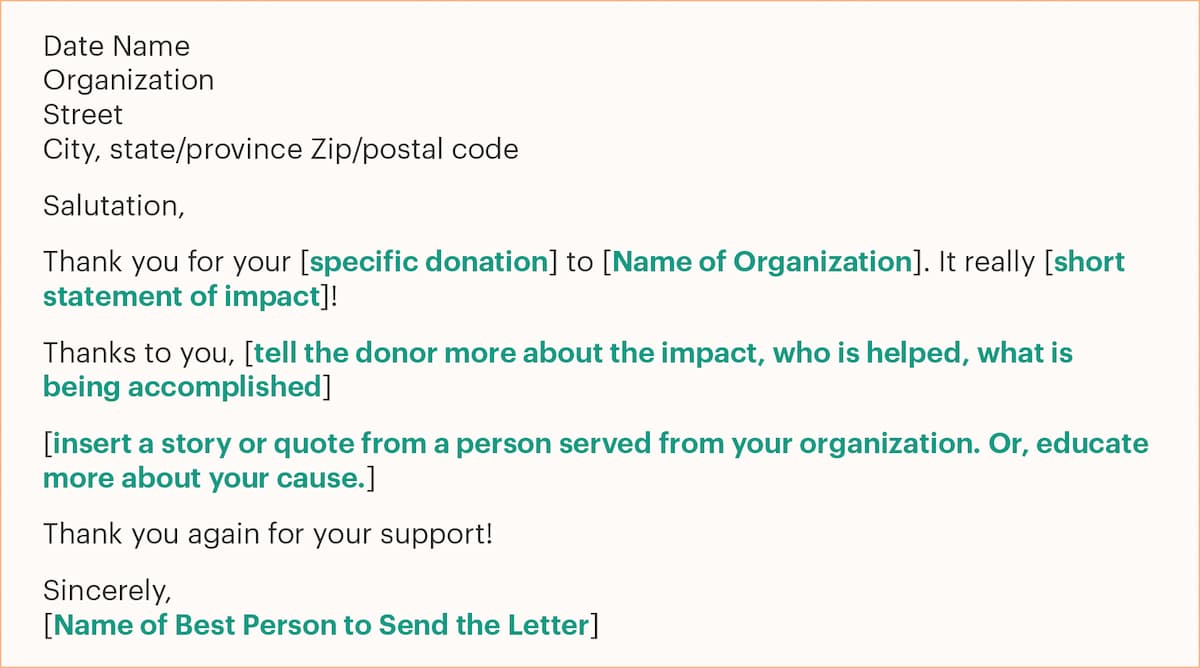
Template 2: for In-kind Donation
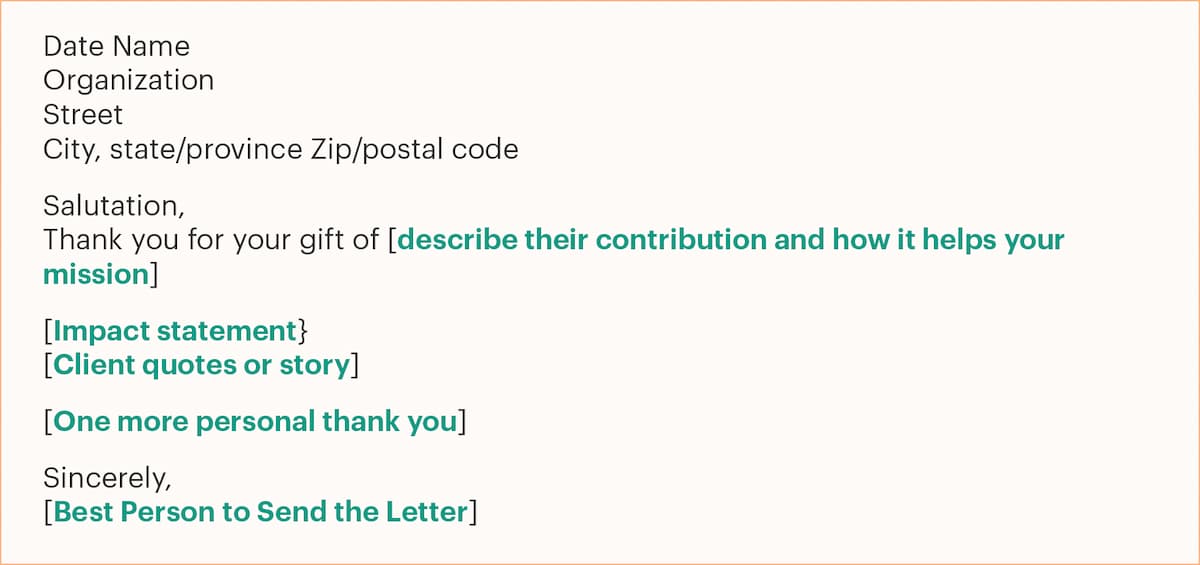
Template 3: Matching Gift Version
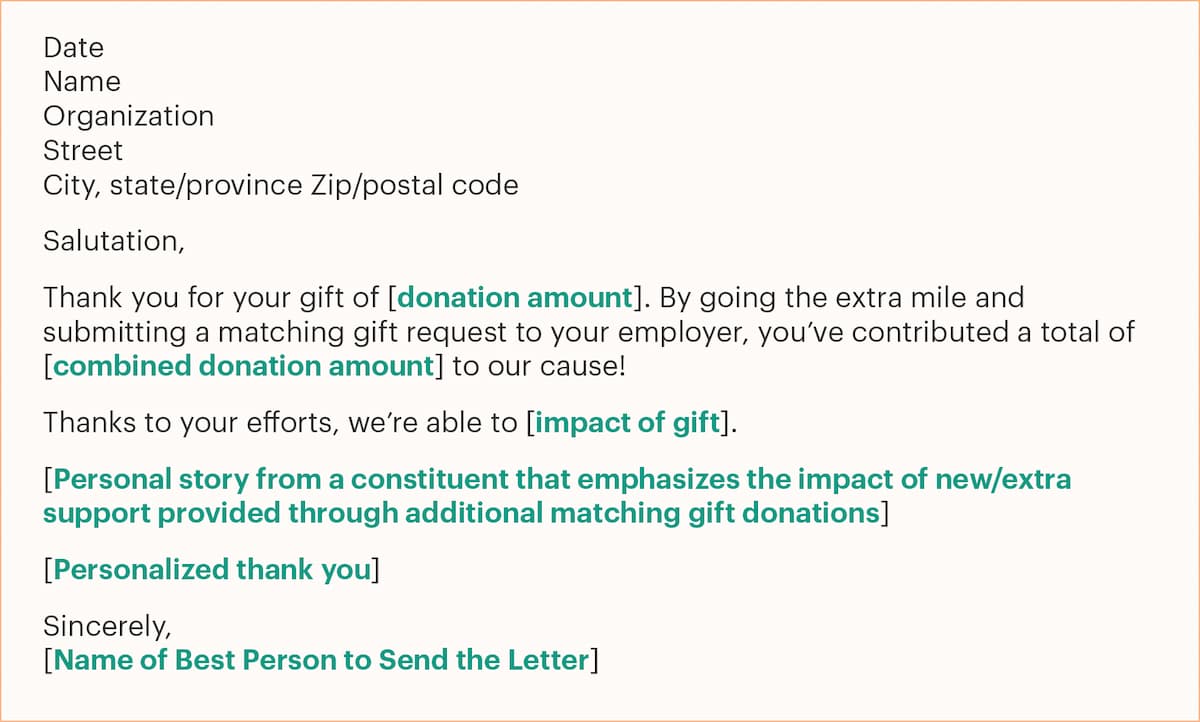

How to Distribute Your Thank You Letter
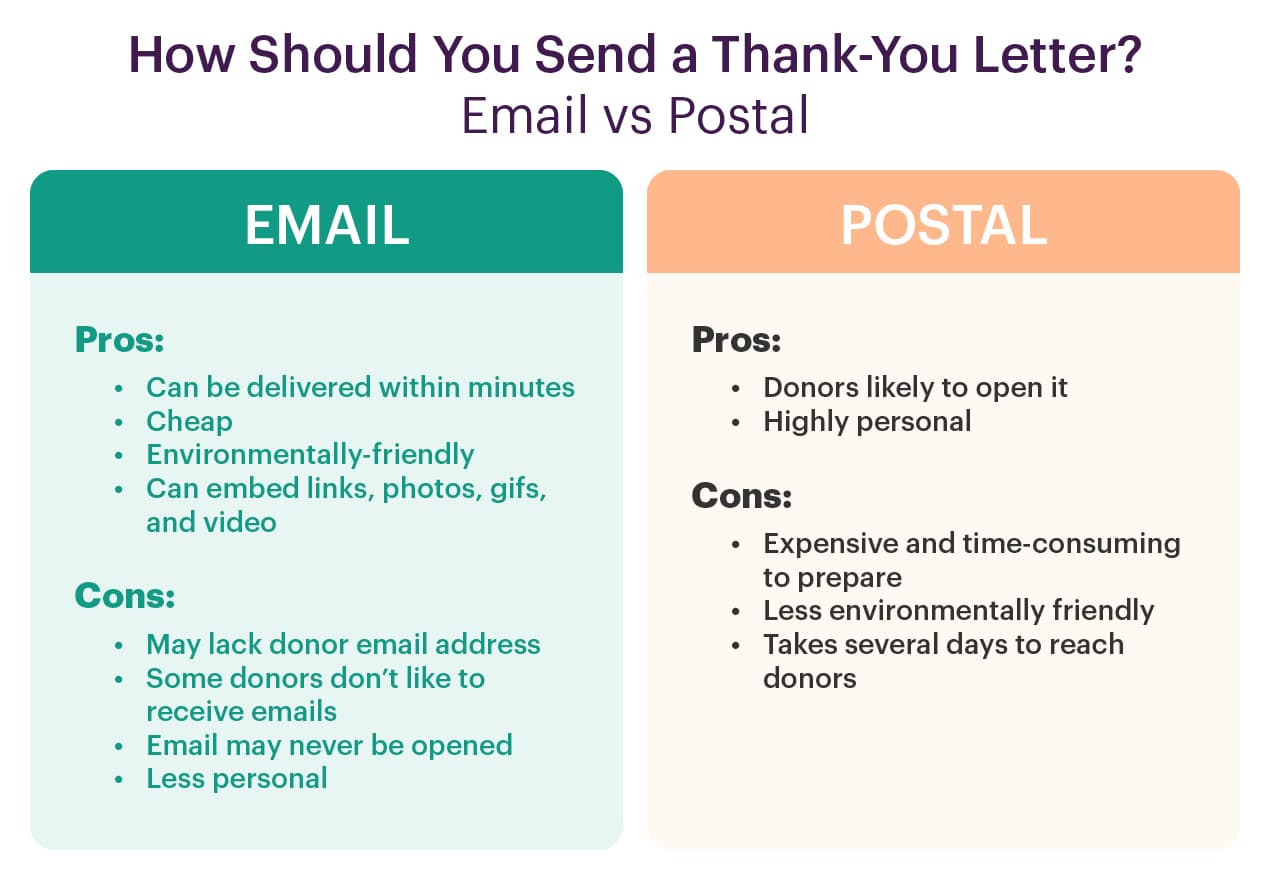
Thank you letters can be sent via email or postal mail. While the choice is up to you, there are a few things to consider regarding both options.
Pros:
- Can be delivered within minutes after the donor makes a gift
- It’s faster, cheaper, and more environmentally friendly
- You can embed links, photos, gifs, or even video
Cons:
- You won’t always have the donor’s email address
- Some donors, especially older ones, don’t like to receive emails
- There’s a good chance the email will never be opened
- It’s less personal and isn’t appropriate for substantial donations
Postal mail:
Pros:
- Donors will definitely open it
- It’s more personal and can be further personalized with a handwritten message in the margins
Cons:
- More expensive and time consuming to prepare
- Less environmentally friendly
- Can take a few days to reach the donor
Which one to choose:
If you’re not sure which option is best for you, consider following this guideline: do what the donor did — if they mailed in their donation, send them a physical thank you letter; if they gave online, send them an email.
You can even take this one step further and ask your donors if they have a preference. Some will indicate that they don’t like receiving emails, so be sure to follow that request.
Some donors may indicate that they like receiving physical letters but can’t read your typical font size. In this case, take the time to print a special letter that’s easy for them to read.
For major donors and substantial gifts, always send a physical letter or even a handwritten note.
7 More Creative Ways to Thank Your Donors
Video: Creating a video thank you letter can make a big impression on your donors, showing them you care and keeping them engaged with your cause. Even if it’s a simple video, shared with a broad donor audience, it shows effort. You can even record videos on a cell phone as long as you have good audio quality. No high-production value needed here!
eCards: Combine the fun of postcards and the speed of email thank yous with eCards. eCards are electronic greeting cards that you can customize to feature memorable, branded imagery of your nonprofit and personalized messages to create a thank you method donors will remember.
Text: 90-95% of people open a text within 3 minutes. If you have permission to text donors, sending a brief thank you note this way boosts the likelihood they’ll read it. It’s no substitute for a written letter, but it can be more immediate than an email (and serve the same purpose!).
Website: Your website is a great place to put out a general thank you to donors and highlight individual stories and testimonials. Feature specific donors on your website, sharing their gift amount, what your cause means to them, and what you’ve been able to accomplish with their generous support. Plus, keep your website updated so supporters can find the latest information about your campaigns and the impacts of their gifts.
Gifts: Want to boost the impact of your thank-you letter? Pair it with a thank-you package, certificate, or swag. Along with showing your appreciation, this approach gives donors something tangible to hold onto, increasing the chances they’ll remember your nonprofit and give again.
Events: What else can you include in your thank you letter? Use it to invite your donors to upcoming events, whether it’s a tour of the site of their impact or a formal dinner and gala.
Anniversary: Besides an immediate thank you letter, you can also surprise major donors with a letter to celebrate their giving anniversary. Donors who have been around for a year—or several!—are incredibly important to your cause. Show them with a thank you letter they might not be expecting!
4 Tips for Perfecting Your Donor Thank You Letter
- Prepare in advance. Automation is your friend! Think through the next steps in the donor journey and prepare automated thank-you notes for supporters based on where they are in that journey. Create a template and add personal touches for each donor, such as their name, total donated, and updates on specific campaigns they’ve given to.
- Be flexible. Different donors prefer to receive thank you messages in different ways. Create various types of thank you letters based on your donors’ preferences, whether that’s email, text, video, or a physical note.
- Optimize your graphic design. Photos and illustrations are fun extra components you can add to thank you messages to increase their memorability and make your nonprofit stand out. Your letters, emails, and other written communication should have standardized branding, which includes uniform fonts, colors, and logos, to make it clear they’re coming from your nonprofit. Create these images in-house with design tools or hire a professional graphic designer to create needed imagery and even help you solidify your brand strategy.
- Stay connected. After you thank a donor, what comes next? Keep them engaged with your mission and organization by regularly thanking donors for their support in your communications.
Thank Your Donors the Right Way
Sending a well crafted, personalized thank you letter to your donors is a simple gesture that can have a big impact on their experience and their relationship with your organization. When you take the time to write meaningful personal messages of gratitude, you nurture a community of donors that will continue to actively support your cause for years to come.
Read More: Donor Relationships: Why You Should Treat Them Like a Marriage
If you’re curious about how to better manage your donor data so you can later use it to personalize thank you letters, you may be interested in membership management software like WildApricot. It works for both members and donors, so you can nurture your relationships and grow your community.
The best part about WildApricot is that you can also use it to build a custom website for your nonprofit and even create a donation page. When someone makes an online donation, their information will automatically get added to your database, so you never have to worry about missing data.
Click here to learn more about WildApricot or start a free 60 day trial today!





